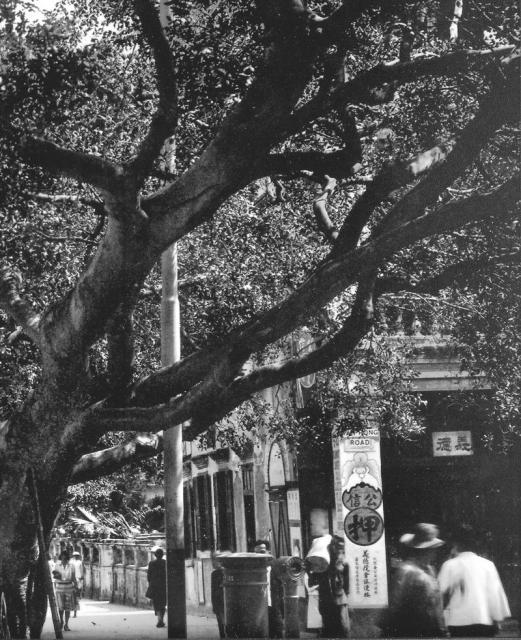Photo cropped from here
Note the oval postbox, street fire alarm and "Haiphong Road" street sign (ceramic tiles ?) at the junction.
Date picture taken
1920s
Gallery
Shows place(s)
Shows street(s)

Comments
Location?
Although there is a sign reading Haiphong Road, the location looks unfamiliar to me. If this would be the junction of Nathan Road and Haiphong Road, on the right I would expect the entrance to Whitfield Barracks and not a building. Whitfield Barracks were on War Department Land, no private building would normally be allowed.
A possibility would be the junction of Canton Road and Haiphong Road looking north. There was a building, the one visible could be the same with a new utilisation.
The Chinese Houses on 55-45 Haiphong Road are on the opposite side of the road and not visible.
Re: Location
I thought one was looking south on Nathan Road with the postbox and lamp post on the northern side of the junction and the building on the opposite (southern) side ? The entrance to Whitfield Barracks is out of sight on the right. Further up Nathan Road beyond the building would be the Station Hotel ?
Re: Location
Looking to the south from the northern edge of Haiphong Road fits with the postbox and the electricity pole being on the left side. See this photo from the 1940s
But there are three things that don't match
Possibly the Chinese letters on the building can help.
Re: Chinese Houses
I am just going with the approximate date range that has been given to the Chinese houses i.e. from the 1900s. I have not looked into when they were built but I think the building architecture are similar, if not the same.
With regard to vehicular traffic flow, the trees that line Nathan Road have always been a contentious issue. Calls for their removal go way back. Not surprised that the tree(s) has been removed from the road junction in later decades.
Next to the pawn shop sign on the pillar and to the right of the "Haiphong Road" sign are two Chinese characters, "Yee Tack". From the signage, the "Yee Tack" business appears to have started off as being an authorised pawn shop and later became a money changer and a seller of tobacco products. The business sign, "Yee Tack" appears in English in later photos of the junction.
1920s Nathan Road (Complete Photo)
Managed to locate and retrieve the original photo. Whitfield Barracks is on the right.
Greencroft
Does the low wall on the left of the close up belong to Greencroft?
Location!
Yes moddsey, that is totally convincing. On the original photo I thought the building would only have one storey with a roof terrace, but it is a balcony in a three-storey building.
Phil, I think the low wall belongs to the Station Hotel. The rear part of the Haiphong Road houses can be seen on the right.
Re: Rear Part of the Haiphong Road Houses
The Station Hotel on KIL No. 402 was immediately south of the Haiphong Road houses. Later with redevelopment, a new road junction would be formed between Lock Road and Nathan Road at the rear part of the Haiphong Road houses. We see this junction in photos from the 1950s here.
Yet to see pre-war views of this junction. The 1938 Street Index indicates that Lock Road was a dead end street that terminated at the rear of KIL No. 402.